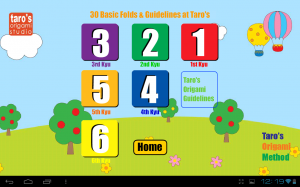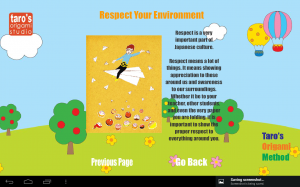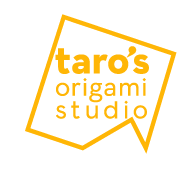Taro's Origami Method: Basic Folds and Mastery Levels (Kyu)
Taro's teachers ask students to master a series of "basic folds" that are fundamental to any possible end product. We have classified these basic folds or forms (kata) according to difficulty and lined up the levels of difficulty as separate kyu (levels). Students get to learn and master the sixth kyu-level (yellow) and work up to the first kyu (red). To advance to a higher level, students are tested in a variety of basic folds from both their current kyu and from any building up to it. The basic folds enable folding of future models and need to be mastered for future growth. We think that it is important for each student to grasp basic folds thoroughly.

Kyu Level and Advancement – “6-kyu” through “1-kyu”
All origami begins with the same basic folds called “KATA” in Japanese. It is a system very similar to the way karate is taught. Instead of mastering and then demonstrating martial art forms, we ask students to master and then demonstrate a series of folds before advancing to the next level – or Kyu level. Here, we use colored wristbands that represent a student’s skill level – as opposed to belts. We have classified the basic folds or “KATA” according to difficulty so that a student’s skill will develop gradually in a logical and systematic manner.
Skills learned in the very beginning are carried throughout all of the levels.
The folds at our most basic level – yellow – are carried throughout a student’s training. The first few folds may seem simple, but learning the precision and patience necessary to carefully complete “KATA” accurately each time is an invaluable skill we strive to instill. Even when a student attains the highest rank, they will still incorporate even the most basic folds to the most intricate models. Understanding the relationship between the simplest folds and how the most advanced models rely on these foundational steps is key to understanding origami.
Samples that can be folded in each KYU






Above models are folded from following our standard text books:
Education & Development through Origami
Origami is not simply a hobby.
 In addition to the joys that come from creating origami, the real world applications of developing this skill extend to countless aspects of our everyday lives. It can help nurture the development of a child. Skills like origami are essential in developing coordination between the left and right hemispheres of the brain. Origami can help “lead to more flexible manipulation of ideas and a creative imagination”(Healy 1990).
In addition to the joys that come from creating origami, the real world applications of developing this skill extend to countless aspects of our everyday lives. It can help nurture the development of a child. Skills like origami are essential in developing coordination between the left and right hemispheres of the brain. Origami can help “lead to more flexible manipulation of ideas and a creative imagination”(Healy 1990).
Origami assists the brain in the same manner as learning any other activity through repeated motions – such as music, sports, or other craft-oriented exercises. Students will gain and develop the ability to interpret and understand patterns, understand spatial relationships, and capture and understand both two-and-three-dimensional design elements.
We are creating an environment of learning that extends far beyond just folding paper. Through Taro’s Origami Method, and by applying the skills you develop by studying origami, we firmly believe that educational value exists for everyone, not just for origami enthusiasts.
Taro's KYU Basic Fold Video Lessons
Taro's Basic Model Video Lessons
Taro’s Origami Method Lessons Bundles
-
30 Lesson Bundle: Taro’s Origami Method Kyu Basic Fold Classes$19.90Add to cart
A 6 course bundle, with 30 self learning courses (video instructions) of the kyu fold techniques. It is the best bundle to practice and master Taro’s Origami Method.
-
60 Lessons Bundle: Taro’s Origami Method Basic kyu + Basic models Classes$49.90Add to cart
The 12 Course Bundle of Taro’s Origami Method Basic kyu + Basic models. It is the best bundle to practice and master Taro’s Origami Method, as well as learn…
Want to learn Taro’s Origami Method on-site or online from Taro’s Certified Teachers?
Visit our information page by clicking HERE.














